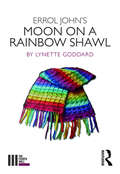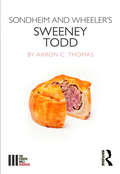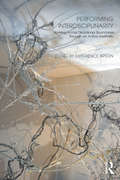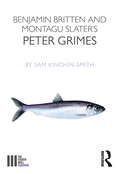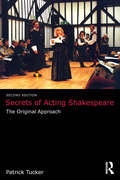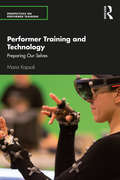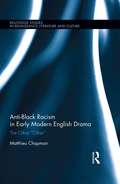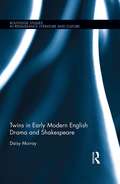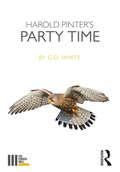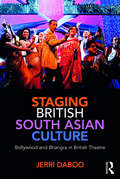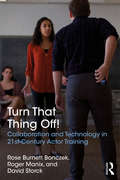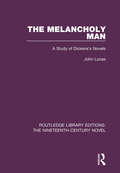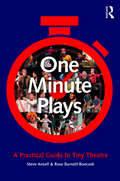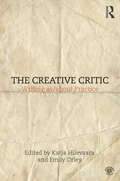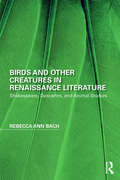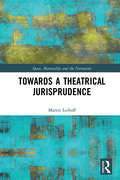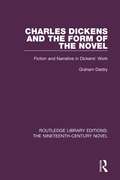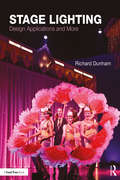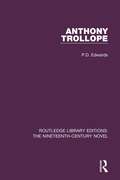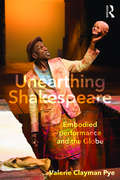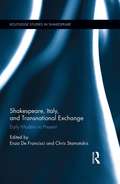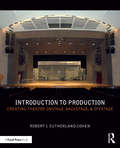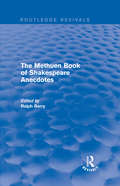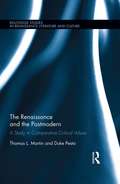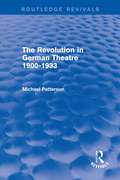- Table View
- List View
Errol John's Moon on a Rainbow Shawl (The Fourth Wall)
by Lynette GoddardErrol John wrote Moon on a Rainbow Shawl (1958) after becoming disillusioned about the lack of good roles for black actors on the British theatre scene. While this situation has only slightly improved since, his response has become the most revived black play in Britain, from its original production at the Royal Court in 1958, to the National Theatre in 2012. It depicts the lives of a black community living in poverty in a shared tenement yard in Port of Spain, Trinidad, in the mid-1940s, showing how each of the characters carries dreams of escaping to create better lives for themselves and their families. Lynette Goddard focuses on how the play articulates the narratives of migration that prompted many Caribbean people to uproot from their homes on the islands and move to the England in the post-war era. For some of them, these dreams of a new life became a reality, but they were experienced differently across genders and generations.
Sweeney Todd
by Aaron C. ThomasSweeney Todd, the gruesome tale of a murderous barber and his pastry chef accomplice, is unquestionably strange subject matter for the musical theatre – but eight Tony awards and enormous successes on Broadway and the West End testify to its enduring popularity with audiences. Written by Hugh Wheeler, with music and lyrics by Stephen Sondheim, the musical premiered in 1979 and has seen numerous revivals, including Tim Burton's 2007 film version. Aaron C. Thomas addresses this darkly funny piece with fitting humour, taking on Sweeney Todd’s chequered history and genre, its treatment of violence and cannibalism, and its sexual politics.
Performing Interdisciplinarity: Working Across Disciplinary Boundaries Through an Active Aesthetic
by Experience BryonPerforming Interdisciplinarity proposes new ways of engaging with performance as it crosses, collides with, integrates and/or disturbs other disciplinary concerns. From Activism and Political Philosophy to Cognitive Science and Forensics, each chapter explores the relationships between performance and another discipline. Including cross-chapter discussions which address the intersections between fields, Performing Interdisciplinarity truly examines the making of meaning across disciplinary conventions. This is a volume for performance practitioners and scholars who are living, learning, writing, teaching, making and thinking at the edges of their specialisms.
Peter Grimes
by Sam Kinchin-Smithã `Who can turn skies back and begin again?' -Peter ã This book contends that Peter Grimes, widely regarded as one of the greatest and most influential operas of the 20th century, is also one of the British theatre's finest `lost' plays. Seeking to liberate Britten and Slater's work from the blinkered traditions of theatre and opera criticism, Sam Kinchin-Smith poses two questions: If an opera was created like a play, and can be staged as a play, is it a play? If a portion of its success and influence is the product of this newly identified theatrical engine, is it then a great play? The answers involve Wagner and W.G. Sebald, George Crabbe and Complicite, Akenfield and Twin Peaks. Challenging long-established narratives of post-war theatre history, this book makes a compelling case for why practitioners and scholars of performance ought to pay more attention to Britten and Slater's achievement - a milestone of unconventional English modernism - and perhaps to other operatic masterpieces too.
Secrets of Acting Shakespeare: The Original Approach
by Patrick TuckerSecrets of Acting Shakespeare isn’t a book that gently instructs. It is a passionate, yes-you-can guide designed to prove that anybody can act Shakespeare. Patrick Tucker’s classic manual encourages trained and amateur actors alike to look to the original practices of the Elizabethan theatre for inspiration. He explores the ‘cue scripts’ used by actors, who knew only their own lines, to demonstrate the extraordinary way that these plays work by ear. This updated second edition includes: A section dedicated to the modes of address 'thee‘ and 'you‘ A brand new chapter on Original Practices and cue scripts An expanded genealogical chart, showing the interrelations of 92 different characters from the history plays A new discussion of Elizabethan acting spaces – balconies, gates, ramparts and even backstage areas Secrets of Acting Shakespeare is a must-read for actors intrigued by the ‘Original Approach’ to acting Shakespeare, or for anyone curious about how the Elizabethan theater worked.
Performer Training and Technology: Preparing Our Selves (Perspectives on Performer Training)
by Maria KapsaliPerformer Training and Technology employs philosophical approaches to technology, including postphenomenology and Heidegger’s thinking, to examine the way technology manifests, influences and becomes used in performer training discourse and practice. The book offers in-depth discussions of present and past performer training practices through a lens that has never been applied before; considers the employment of key digital artefacts; and develops a series of analytical tools that can be useful in scholarly and practical explorations. An array of intriguing subjects are covered including the role of electric lights in Stanislavsky’s work on concentration; the use of handheld tools, such as sticks in Zarrilli’s psychophysical training and Meyerhold’s Biomechanics; the emergence of new forms of training in relation to motion capture technology; and the way the mobile phone complicates notions and practices of attention in learning and training contexts. This book is of vital relevance to performer training scholars and practitioners; theatre, performance, and dance scholars and students; and especially those interested in philosophies of technology.
Anti-Black Racism in Early Modern English Drama: The Other “Other” (Routledge Studies in Renaissance Literature and Culture)
by Matthieu ChapmanThis is the first book to deploy the methods and ensemble of questions from Afro-pessimism to engage and interrogate the methods of Early Modern English studies. Using contemporary Afro-pessimist theories to provide a foundation for structural analyses of race in the Early Modern Period, it engages the arguments for race as a fluid construction of human identity by addressing how race in Early Modern England functioned not only as a marker of human identity, but also as an a priori constituent of human subjectivity. Chapman argues that Blackness is the marker of social death that allows for constructions of human identity to become transmutable based on the impossibility of recognition and incorporation for Blackness into humanity. Using dramatic texts such as Othello, Titus Andronicus, and other Early Modern English plays both popular and lesser known, the book shifts the binary away from the currently accepted standard of white/non-white that defines "otherness" in the period and examines race in Early Modern England from the prospective of a non-black/black antagonism. The volume corrects the Afro-pessimist assumption that the Triangle Slave Trade caused a rupture between Blackness and humanity. By locating notions of Black inhumanity in England prior to chattel slavery, the book positions the Triangle Trade as a result of, rather than the cause of, Black inhumanity. It also challenges the common scholarly assumption that all varying types of human identity in Early Modern England were equally fluid by arguing that Blackness functioned as an immutable constant. Through the use of structural analysis, this volume works to simplify and demystify notions of race in Renaissance England by arguing that race is not only a marker of human identity, but a structural antagonism between those engaged in human civil society opposed to those who are socially dead. It will be an essential volume for those with interest in Renaissance Literature and Culture, Shakespeare, Contemporary Performance Theory, Black Studies, and Ethnic Studies.
Twins in Early Modern English Drama and Shakespeare (Routledge Studies in Renaissance Literature and Culture)
by Daisy MurrayThis volume investigates the early modern understanding of twinship through new readings of plays, informed by discussions of twins appearing in such literature as anatomy tracts, midwifery manuals, monstrous birth broadsides, and chapbooks. The book contextualizes such dramatic representations of twinship, investigating contemporary discussions about twins in medical and popular literature and how such dialogues resonate with the twin characters appearing on the early modern stage. Garofalo demonstrates that, in this period, twin births were viewed as biologically aberrant and, because of this classification, authors frequently attempt to explain the phenomenon in ways which call into question the moral and constitutional standing of both the parents and the twins themselves. In line with current critical studies on pregnancy and the female body, discussions of twin births reveal a distrust of the mother and the processes surrounding twin conception; however, a corresponding suspicion of twins also emerges, which monstrous birth pamphlets exemplify. This book analyzes the representation of twins in early modern drama in light of this information, moving from tragedies through to comedies. This progression demonstrates how the dramatic potential inherent in the early modern understanding of twinship is capitalized on by playwrights, as negative ideas about twins can be seen transitioning into tragic and tragicomic depictions of twinship. However, by building toward a positive, comic representation of twins, the work additionally suggests an alternate interpretation of twinship in this period, which appreciates and celebrates twins because of their difference. The volume will be of interest to those studying Shakespeare and Renaissance Literature in relation to the History of Emotions, the Body, and the Medical Humanities.
Harold Pinter's Party Time (The Fourth Wall)
by White G. D.‘All you have do is shut up and enjoy the hospitality.’ Terry Harold Pinter’s Party Time (1991) is an extraordinary distillation of the playwright’s key concerns. Pulsing with political anger, it marks a stepping stone on Pinter’s path from iconic dramatist of existential unease to Nobel Prize-winning poet of human rights. <P><P> G. D. White situates this underrated play within a recognisably ‘Pinteresque’ landscape of ambiguous, brittle social drama while also recognising its particularity: Party Time is haunted by Augusto Pinochet’s right-wing coup against Salvador Allende’s democratically elected government in Chile. <P><P> This book considers Party Time and its confederate plays in the dual context of Pinter’s literary career and burgeoning international concern with human rights and freedom of expression, contrasting his uneasy relationship with the UK’s powerful elite with the worldwide acclaim for his dramatic eviscerations of power.
Staging British South Asian Culture: Bollywood and Bhangra in British Theatre
by Jerri DabooStaging British South Asian Culture: Bollywood and Bhangra in British Theatre looks afresh at the popularity of forms and aesthetics from Bollywood films and bhangra music and dance on the British stage. From Andrew Lloyd Webber’s Bombay Dreams to the finals of Britain’s Got Talent, Jerri Daboo reconsiders the centrality of Bollywood and bhangra to theatre made for or about British South Asian communities. Addressing rarely discussed theatre companies such as Rifco, and phenomena such as the emergence of large- scale Bollywood revue performances, this volume goes some way towards remedying the lack of critical discourse around British South Asian theatre. A timely contribution to this growing field, Staging British South Asian Culture is essential reading for any scholar or student interested in exploring the highly contested questions of identity and representation for British South Asian communities.
Turn That Thing Off!: Collaboration and Technology in 21st-Century Actor Training
by Rose Burnett Bonczek Roger Manix David StorckAs personal technology becomes ever-present in the classroom and rehearsal studio, its use and ubiquity is affecting the collaborative behaviors that should underpin actor training. How is the collaborative impulse being distracted and what kind of solutions can re-establish its connections? The daily work of a theater practitioner thrives on an ability to connect, empathize, and participate with other artists. This is true at every level, from performing arts students to established professionals. As smartphones, social media, and other forms of digital connectedness become more and more embedded in daily life, they can inhibit these collaborative, creative skills. Turn That Thing Off! Collaboration and Technology in 21st-Century Actor Training explores ways to foster these essential abilities, paving the way for emerging performers to be more present, available, and generous in their work.
The Melancholy Man: A Study of Dickens's Novels (Routledge Library Editions: The Nineteenth-Century Novel #25)
by John LucasFirst published in 1980, this book surveys Dickens’ growing power to drive deep into the causes of his contemporary conditions. It reveals the importance of nature to Dickens as a rich metaphor of human freedom and potentiality, and emphasises his concern with time and the problems of freedom. The author considers the peculiarity of Dickens being unanimously acclaimed as a great writer considering the difficulty in placing him definitively within the literary tradition. The author argues Dickens was an isolated figure, indifferent to changing fashions and with a strong sense of the dignity of human nature and that this formed the basis of his character and writings.
One Minute Plays: A Practical Guide to Tiny Theatre
by Steve Ansell Rose Burnett BonczekCan you really write a play that lasts a minute? The one minute play offers a unique challenge to actors, directors and writers: how do you create a whole world, where actors have room to perform and where audiences have a true experience all in 60 seconds? One Minute Plays: A Practical Guide to Tiny Theatre demystifies the super-short-form play, demonstrating that this rich, accessible format offers great energy and variety not only to audiences but to everyone involved in its creation and performance. This handbook includes: An anthology of 200 one-minute plays selected from the annual Gone in 60 Seconds festival. A toolbox of exercises, methodologies and techniques for educators, practitioners and workshop leaders at all levels. Tips and advice on the demands of storytelling, inclusivity and creative challenges. Detailed practical information about creating your own minute festival, including play selection, running order, staging and marketing. Drawing on a wealth of experience, Steve Ansell and Rose Burnett Bonczek present an invaluable guide for anyone intrigued by the art of creating, producing and performing a one minute play.
The Creative Critic: Writing as/about Practice
by Katja Hilevaara Emily OrleyAs practitioner-researchers, how do we discuss and analyse our work without losing the creative drive that inspired us in the first place? Built around a diverse selection of writings from leading researcher-practitioners and emerging artists in a variety of fields, The Creative Critic: Writing as/about Practice celebrates the extraordinary range of possibilities available when writing about one’s own work and the work one is inspired by. It re-thinks the conventions of the scholarly output to propose that critical writing be understood as an integral part of the artistic process, and even as artwork in its own right. Finding ways to make the intangible nature of much of our work ‘count’ under assessment has become increasingly important in the Academy and beyond. The Creative Critic offers an inspiring and useful sourcebook for students and practitioner-researchers navigating this area. Please see the companion site to the book, http://www.creativecritic.co.uk, where some of the chapters have become unfixed from the page.
Birds and Other Creatures in Renaissance Literature: Shakespeare, Descartes, and Animal Studies (Perspectives on the Non-Human in Literature and Culture)
by Rebecca Ann BachThis book explores how humans in the Renaissance lived with, attended to, and considered the minds, feelings, and sociality of other creatures. It examines how Renaissance literature and natural history display an unequal creaturely world: all creatures were categorized hierarchically. However, post-Cartesian readings of Shakespeare and other Renaissance literature have misunderstood Renaissance hierarchical creaturely relations, including human relations. Using critical animal studies work and new materialist theory, Bach argues that attending closely to creatures and objects in texts by Shakespeare and other writers exposes this unequal world and the use and abuse of creatures, including people. The book also adds significantly to animal studies by showing how central bird sociality and voices were to Renaissance human culture, with many believing that birds were superior to some humans in song, caregiving, and companionship. Bach shows how Descartes, a central figure in the transition to modern ideas about creatures, lived isolated from humans and other creatures and denied ancient knowledge about other creatures’ minds, especially bird minds. As significantly, Bach shows how and why Descartes’ ideas appealed to human grandiosity. Asking how Renaissance categorizations of creatures differ so much from modern classifications, and why those modern classifications have shaped so much animal studies work, this book offers significant new readings of Shakespeare’s and other Renaissance texts. It will contribute to a range of fields, including Renaissance literature, history, animal studies, new materialism, and the environmental humanities.
Towards a Theatrical Jurisprudence
by Marett LeiboffThis book brings the insights of theatre theory to law, legal interpretation and the jurisprudential to reshape law as a practice of response and responsibility. Confronting a Baconian antitheatrical legality embedded in its jurisprudences and interpretative practices, Marett Leiboff turns to theatre theory and practice to ground a theatrical jurisprudence, taking its cues from Han-Thies Lehmann’s conception of the post-dramatic theatre and the early work of theatre visionary Jerzy Grotowski. She asks law to move beyond an imagined ideal grounded in Aristotelian drama and tragedy, and turns to the formation of the legal interpreter ・ lawyer, judge, jurisprudent ・ as fundamental to understanding what’s “noticed” or not noticed in law. We “notice” most easily through that which is written into the body of the legal interpreter, in a way that can’t be replicated through law’s standard practices of thinking and reasoning. Without more, thinking and reasoning are the epitome of antitheatricality legality; a set of theatrical antonyms, including transgression and instinct, offer instead a set of possibilities through which to reconceive assumptions and foundational concepts etched into the legal imaginary. And by turning to critical dramaturgy, the book reveals that the liveliness that sits behind theatrical jurisprudence isn’t a new concept in law at all, but has a long pedigree and lineage that had been lost and hidden. Theatrical jurisprudence, which demands an awareness of self and beyond self, grounds a responsiveness that can’t be found within doctrine, principle, or the technocratic, but also challenges us to notice what it is we think we know as well as what we know of lives in law that aren’t our own. The book will be of interest to scholars and students in the field of jurisprudence, legal theory, theatre and performance studies, cultural studies and philosophy.
Charles Dickens and the Form of the Novel: Fiction and Narrative in Dickens' Work (Routledge Library Editions: The Nineteenth-Century Novel #8)
by Graham DaldryFirst published in 1987. While there have been commentaries on his humour, his seriousness, his social concerns, and other specific aspects of his work such accounts have only tended to divide our understanding of the novels, to lead us to see them as failures of artistic unity. In this book the author seeks to address this question of unity and find a terminology that can treat language, plot and representation of reality as a coherent imaginative effort. This thesis is worked out in detail with reference to several of the novels, and represents a challenging re-evaluation Dickens’ achievement as a novelist. This book will be if interest to student of literature.
Stage Lighting: Design Applications and More
by Richard E DunhamStage Lighting: Design Applications and More builds upon the information introduced in Stage Lighting: The Fundamentals to provide an in-depth reference to a number of specialty areas of lighting design, from traditional applications such as drama, dance, and designing for different venues, to more advanced applications such as concert, corporate, film and video, virtual, architectural/landscape, and other forms of entertainment lighting. Each chapter gives the essential background, design practices, and equipment details for each specialization, so readers can make informed decisions and ask informed questions when encountering each field. The book provides insight on the latest technology and includes profiles of prolific designers, such as James Moody, Jeff Ravitz, Alan Adelman, and Paul Gregory. Stage Lighting: Design Applications and More is intended to help lighting designers translate their theatrical skills to other areas of lighting design, and provides guidance on how to take those initial steps into new ventures in their lighting careers.
Anthony Trollope: His Art And Scope (Routledge Library Editions: The Nineteenth-Century Novel #12)
by P.D. EdwardsFirst published in 1968, this book sets out to refute the idea of Trollope as a ‘mild cathedral-town novelist, describing storms in ecclesiastical tea cups’ which prevailed at the time in spite of his stature during his lifetime. The author reveals the full strength and range of Trollope’s achievement and provides an excellent introduction to further exploration of the novels. Two sections — ‘Narrative Method’ and ‘Subject-Matter’ — are used as the basis from which the author examines key themes in Trollope’s work, with instructive extracts from the novels included to illustrate these points and upon which commentary is provided. This book will be of interest to students of literature.
Unearthing Shakespeare: Embodied Performance and the Globe
by Valerie Clayman PyeWhat can the Globe Theatre tell us about performing Shakespeare? Unearthing Shakespeare is the first book to consider what the Globe, today’s replica of Shakespeare’s theatre, can contribute to a practical understanding of Shakespeare’s plays. Valerie Clayman Pye reconsiders the material evidence of Early Modern theatre-making, presenting clear, accessible discussions of historical theatre practice; stages and staging; and the relationship between actor and audience. She relays this into a series of training exercises for actors at all levels. From "Shakesball" and "Telescoping" to Elliptical Energy Training and The Radiating Box, this is a rich set of resources for anyone looking to tackle Shakespeare with authenticity and confidence.
Shakespeare, Italy, and Transnational Exchange: Early Modern to Present (Routledge Studies in Shakespeare)
by Enza De Francisci Chris StamatakisThis interdisciplinary, transhistorical collection brings together international scholars from English literature, Italian studies, performance history, and comparative literature to offer new perspectives on the vibrant engagements between Shakespeare and Italian theatre, literary culture, and politics, from the sixteenth to the twenty-first century. Chapters address the intricate, two-way exchange between Shakespeare and Italy: how the artistic and intellectual culture of Renaissance Italy shaped Shakespeare’s drama in his own time, and how the afterlife of Shakespeare’s work and reputation in Italy since the eighteenth century has permeated Italian drama, poetry, opera, novels, and film. Responding to exciting recent scholarship on Shakespeare and Italy, as well as transnational theatre, this volume moves beyond conventional source study and familiar questions about influence, location, and adaptation to propose instead a new, evolving paradigm of cultural interchange. Essays in this volume, ranging in methodology from archival research to repertory study, are unified by an interest in how Shakespeare’s works represent and enact exchanges across the linguistic, cultural, and political boundaries separating England and Italy. Arranged chronologically, chapters address historically-contingent cultural negotiations: from networks, intertextual dialogues, and exchanges of ideas and people in the early modern period to questions of authenticity and formations of Italian cultural and national identity in the eighteenth and nineteenth century. They also explore problems of originality and ownership in twentieth- and twenty-first-century translations of Shakespeare’s works, and new settings and new media in highly personalized revisions that often make a paradoxical return to earlier origins. This book captures, defines, and explains these lively, shifting currents of cultural interchange.
Introduction to Production: Creating Theatre Onstage, Backstage, & Offstage
by Robert I. Sutherland-CohenIntroduction to Production: Creating Theatre Onstage, Backstage, & Offstage defines the collaborative art of making theatre and the various job positions that go into realizing a production. Beginning with an overview of the art and industry of theatre, the book shows how theatre has evolved through history. The book then breaks down the nuts and bolts of the industry by looking at each professional role within it: from the topmost position of the producer down to the gopher, or production assistant. Each of these positions are defined along with their respective duties, rules, and resources that figure in obtaining these jobs. Each chapter offers exercises, links to videos and websites, review quizzes, and suggested readings to learn more about the creation and production of theatre.
The Methuen Book of Shakespeare Anecdotes
by Ralph BerryFew playwrights have been more slandered, abused or honoured in performance than William Shakespeare. First published in 1992, this collection of 300 stories focuses on Shakespeare’s plays on stage. Organised chronologically, it offers the reader the opportunity to witness the changes in theatrical approaches to Shakespeare from their own time to the present day. This book will be of interest to those studying theatre, but also to those fascinated by the Shakespeare tradition.
The Renaissance and the Postmodern: A Study in Comparative Critical Values (Routledge Studies in Renaissance Literature and Culture)
by Thomas L Martin Duke PestaThe Renaissance and the Postmodern reconsiders postmodern readings of Renaissance texts by engaging in a dialectics the authors call comparative critical values. Rather than concede the contemporary hierarchy of theory over literature, the book takes the novel approach of consulting major Renaissance writers about the values at work in postmodern representations of early modern culture. As criticism seeks new directions and takes new forms, insufficient attention has been paid to the literary and philosophical values won and lost in the exchanges. One result is that the way we understand the logical connections, the literary textures, and the philosophical impulses that make up the literature of writers like Spenser, Shakespeare, and Milton has fundamentally changed. Examining theoretical debates now in light of polemical controversies then, the book goes beyond earlier studies in that it systematically examines the effects of these newer critical approaches across their materialist, historicist, deconstructive, and psychoanalytic manifestations. Bringing gravity and focus to this question of critical continuities and discontinuities, each chapter counterposes one major Renaissance voice with a postmodern one to probe these issues and with them the value of the cultural past. As voices on both sides of the historical divide illuminate key differences between the Renaissance and the Postmodern, a critical model emerges from the book to re-engage this period’s humane literature in a contemporary context with intellectual rigor and a renewed sense of cultural enrichment.
The Revolution in German Theatre 1900-1933 (Routledge Revivals)
by Michael PattersonFirst published in 1981, this book represents the first work in English to give a comprehensive account of the revolutionary developments in German theatre from the decline of Naturalism through the Expressionist upheaval to the political theatre of Piscator and Brecht. Early productions of Kaiser’s From Morning till Midnight and Toller’s Transfiguration are presented as examples of Expressionism. A thorough analysis of Piscator’s Hoppla, Such is Life! And Brecht’s Man show the similarities and differences in political theatre. In addition, elements of stage-craft are examined — illustrated with tabulated information, an extensive chronology, and photographs and designs of productions.
